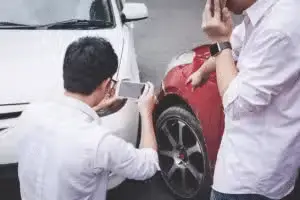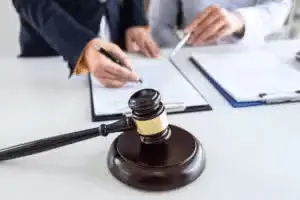Evidence

Evidence is critical to just about every personal injury case. You will submit evidence with your insurance claim after a car accident. You will need evidence to prove medical malpractice. You will even need evidence showing your economic and non-economic losses after you prove a business bears premises liability for your slip and fall accident.
You and your personal injury lawyer will use evidence to prove many facts in your case. This evidence can come in a number of different forms. But regardless of the form or purpose of the evidence, it must meet certain standards for a court to admit it.
Here is an overview of the evidence you might use in California to prove your injury case.
Table of Contents
Evidence Under California Law

Evidence includes any information that tends to prove or disprove a fact. Evidence can take many forms, including:
Testimonial Evidence
Evidence can include written or oral testimony from witnesses. Fact witnesses can testify about something they perceived or came to learn.
Expert witnesses can also give opinion-based testimony gathered from their experience, knowledge, or education. For example, an accident reconstruction expert can give an opinion about how an accident happened.
The jury or claims adjuster can use testimony in weighing who bears the fault for an accident.
Documentary Evidence
Documentary evidence includes anything that is recorded. This includes:
- Written documents, like medical records or pay stubs
- Videos
- Sound recordings
- Photographs
Documentary evidence must get authenticated before a court will allow its use. You must show that the documents were in your possession and were not altered.
Physical Evidence
Physical evidence can include objects and even people. A broken lightbulb, the shoes you were wearing during your slip and fall accident, or a damaged brake pedal could constitute physical evidence.
Physical evidence could also include your own body. For example, your lawyer might ask you to show a jury your scars from your injury or demonstrate the range of motion in your injured knee.
Bear in mind that a photo or video of an object does not qualify as physical evidence. Only the object itself qualifies as physical evidence. A photo or video of the object would instead be considered a form of documentary evidence.
Admissible vs. Inadmissible Evidence
Evidence includes anything that bears on the truth or falsity of a fact. A claims adjuster will usually consider anything you submit, whether a court would admit it into evidence or not.
But a judge will not necessarily allow you to use every piece of evidence you have. Instead, a judge can rule on the admissibility of your evidence.
You have probably heard lawyers object to evidence if you have ever watched a trial or even a courtroom drama. A judge sustains the objection when the evidence is inadmissible.
Judges can exclude inadmissible evidence for a variety of reasons, including:
Hearsay
Hearsay includes all out-of-court statements introduced to prove the subject of the statement. Suppose that another driver said, “I’m sorry — that was my fault” after a car accident. You cannot introduce that statement to prove fault unless one of the hearsay exceptions applies.
Settlement Negotiations
You cannot use any statements or conduct that happened during settlement negotiations. The rules of evidence encourage settlement discussions without fear that the other party could use them against you.
For example, suppose that you got injured in a store when an employee hit you with a pallet jack. During settlement negotiations, the store’s lawyer says you were the only customer ever to be injured that way and that the employee was fired. You cannot introduce that statement to try to prove liability because it came to light during settlement discussions.
Prejudicial Evidence
Prejudicial evidence causes the jury to “prejudge” the case without hearing the facts. A judge can exclude prejudicial evidence so the jury can focus on probative evidence.
Suppose that a driver has a 10-year old DUI conviction. The accident between you and the driver did not involve intoxicated driving. A judge would likely rule the old DUI conviction to be inadmissible.
If this was not the case, the jury might focus on whether the other driver was a “bad guy” for getting a DUI rather than focusing on whether the driver caused your accident.
Collecting Evidence
Your injury lawyer will investigate your case and gather evidence. This evidence will include anything that proves liability and damages.
The evidence in your case will probably cover testimony from witnesses of the accident, medical records, and financial documents. It may also include opinions from experts, like medical experts, about your injuries, their cause, and your prognosis.
Your lawyer will include this evidence with your insurance claim. A claims adjuster will consider the evidence in deciding whether to accept or deny your claim.
If you cannot resolve the matter with the insurer, you can file a lawsuit. If your case reaches trial, a judge will rule on the admissibility of your evidence. Your lawyer will present the admissible evidence to the jury.
Experienced litigators are often a good choice to handle your personal injury case because they think early in the case about the evidence they need. To learn more about the evidence you need for your case, contact M&Y Personal Injury Lawyers today to schedule a free consultation.
RESOURCES
- Claim vs. Lawsuit
- Evidence
- Six Questions to Ask a Personal Injury Lawyer in Los Angeles, CA During a Free Consultation
- Types of Damages Available in Los Angeles Personal Injury Cases
- Understanding the Statute of Limitations in California
- What Are Economic Damages?
- What Is Causation?
- When Should I Hire a Personal Injury Lawyer in LA?
- View All +
PRACTICE AREAS
SEARCH OUR SITE
OUR OFFICES
6300 Wilshire Blvd. Suite 807
Los Angeles, CA 90048
Los Angeles Law Office Map
350 S Figueroa St. Suite 276
Los Angeles, CA 90071
Downtown Los Angeles Law Office Map
Call: (877) 751-8953
402 W. Broadway #400
San Diego, CA 92101
Call: (619) 404-2797
2400 E Katella #800
Anaheim, CA 92806
Call: (714) 386-7623
8050 N. Palm Ave. #300
Fresno, CA 93711
Call: (559) 853-4863
6360 Van Nuys Blvd. #219
Van Nuys, CA 91401
Call: (213) 296-1243
11801 Pierce Street #200
Riverside, CA 92505
Call: (951) 234-5468
99 S Almaden Blvd #600
San Jose, CA 95113
Call: (408) 617-8928
111 West Ocean Blvd. #400
Long Beach, CA 90802
Call: (562) 354-8219
473 E. Carnegie Drive #200
San Bernardino, CA 92408
Call: (818) 650-3861
